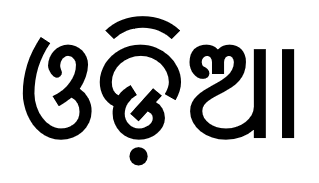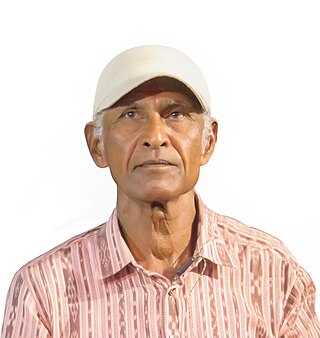Related Research Articles

Languages spoken in the Republic of India belong to several language families, the major ones being the Indo-Aryan languages spoken by 78.05% of Indians and the Dravidian languages spoken by 19.64% of Indians; both families together are sometimes known as Indic languages. Languages spoken by the remaining 2.31% of the population belong to the Austroasiatic, Sino–Tibetan, Tai–Kadai, and a few other minor language families and isolates. According to the People's Linguistic Survey of India, India has the second highest number of languages (780), after Papua New Guinea (840). Ethnologue lists a lower number of 456.

Odia is a classical Indo-Aryan language spoken in the Indian state of Odisha. It is the official language in Odisha, where native speakers make up 82% of the population, and it is also spoken in parts of West Bengal, Jharkhand, Andhra Pradesh and Chhattisgarh. Odia is one of the many official languages of India; it is the official language of Odisha and the second official language of Jharkhand. The Odia language has various dialects varieties, including the Baleswari Odia, Kataki, Ganjami Odia, Sundargadi Odia, Sambalpuri, Desia and Tribal Community dialects who spoken by the tribals groups in Odisha who adopted the Odia language.
Lomavren is a nearly extinct mixed language spoken by the Lom people, that arose from language contact between a language related to Romani and Domari and the Armenian language. The language is also known as Bosa and Bosha.

Nagpuri is an Indo-Aryan language spoken in the Indian states of Jharkhand, Chhattisgarh, Odisha and Bihar. It is primarily spoken in the west and central Chota Nagpur plateau region. It is sometimes considered a dialect of Bhojpuri.
Odisha is one of the 28 states of India, located on the eastern coast. It is surrounded by the states of West Bengal to the northeast, Jharkhand to the north, Chhattisgarh to the west and northwest, and Andhra Pradesh to the south and southwest. Odia is the official and most widely spoken language, spoken by 33.2 million according to the 2001 Census. The modern state of Odisha was established on 1 April 1936, as a province in British India, and consisted predominantly of Odia-speaking regions. April 1 is celebrated as Odisha Day.

Sambalpuri is an Indo-Aryan language variety spoken in western Odisha, India. It is alternatively known as Western Odia, and as Kosali, a recently popularised but controversial term, which draws on an association with the historical region of Dakshina Kosala, whose territories also included the present-day Sambalpur region.

The Eastern Indo-Aryan languages, also known as Māgadhan languages, are spoken throughout the eastern region of the Indian subcontinent, which includes Bihar, Uttar Pradesh, Jharkhand, Bengal region, Tripura, Assam, and Odisha; alongside other regions surrounding the northeastern Himalayan corridor. Bengali is official language of Bangladesh and the state of West Bengal, Tripura and the Barak valley of Assam while Assamese and Odia are the official languages of Assam and Odisha, respectively. The Eastern Indo-Aryan languages descend from Abahattha, which descends from Magadhan Apabhraṃśa and ultimately from Magadhi Prakrit.
The first Sambalpuri movie released was Bhukha. It was released in the year 1989 and was directed by Sabyasachi Mohapatra. It was also the first film from Western Odisha to get an International Jury Award at the Gijon International Film Festival. The second film in Sambalpuri language is Ulugulan (Revolution), which was released in 2008, directed by Mahmood Hussain and produced by Purnabasi Sahu. Its story is set in the first half of the 18th century and depicts the tyrannical rule of the Nagpur rulers.

Dr. Haldhar Nag born 31 March 1950) is a Sambalpuri poet and writer from Bargarh, Odisha, India. Popularly known as "Lok Kabi Ratna", meaning "folk poet gem"). He was awarded Padma Shri, the fourth highest civilian award of India by Government of India in 2016.

Sabyasachi Mohapatra is an Indian film director, writer, and producer in Odia cinema. He owns a production house named Mohapatra Movie Magic.

Baleswari Odia, also Northern Odia or North Balasore Odia, is a dialect of Odia spoken in the northern regions of Indian state of Odisha. It is spoken in the districts of Balasore, Bhadrak, Mayurbhanj and Kendujhar.
Sambalpuri Odia drama are a typical drama performance in Sambalpuri Odia language of Odisha, India.
Juray is a Munda language of India, spoken in Gajapati district in southern Odisha. It is very close to Sora: Gregory Anderson (2008:299) considers Juray to be a Sora dialect. It is currently severely endangered.
Sinapali is the main town in Sinapali Tehsil in the south of Nuapada District in Odisha, India.
The Eighth Schedule to the Constitution of India lists the languages officially recognized by the Government of India. As of 2024, 22 languages have been classified under the schedule.

Jitendra Haripal, a singer, is most popularly known for his voice in the famous and super hit Rangabati Song in Sambalpuri language of Odisha. He sang this duet song with his female co-singer Krishna Patel. He has sung over 1000 songs and regarded as a top exponent of Sambalpuri language song. He has shared the stage with other leading artists of the State including the former Chief Minister Giridhar Gamang, himself a fine musician. He received the Padma Shri, the fourth highest civilian award of India from the Government of India in 2017 for his contribution to the Indian Music.
Sundargadi Odia or Northwestern Odia is a dialect of the Odia language spoken in the Sundergarh district and parts of adjoining districts of Odisha. It is also spoken in the nearby districts of Jashpur of Chhattisgarh and Simdega of Jharkhand.
Desia, also Desiya, Kotia, Adivasi Odia, Desia Odia or Koraputia or Southwestern Odia, is an Indo-Aryan language variety spoken in Koraput, Nabarangpur, Rayagada, Malkangiri districts Odisha and in the hilly regions of Vishakhapatnam and Vizianagaram districts of Andhra Pradesh. The variant spoken in Koraput is called Koraputia.
Bhulia or Bhuliya is an Indo-Aryan dialect which carries the same name as the Bhulia people of India. It has mainly been classified as a dialect of Chhattisgarhi which in itself is considered a dialect of Hindi.
References
- ↑ Agariya at Ethnologue (18th ed., 2015) (subscription required)
- ↑ "Untitled Document". ciil-ebooks.net. Retrieved 15 March 2024.
- ↑ "A BRIEF HISTORY OF AGHARIA CASTE - PDF Free Download". docplayer.net. Retrieved 15 March 2024.